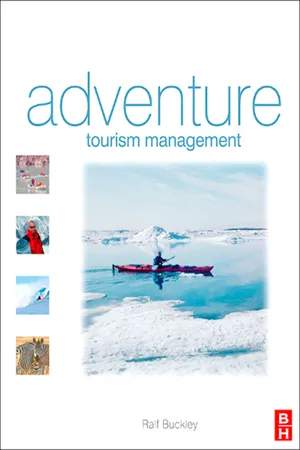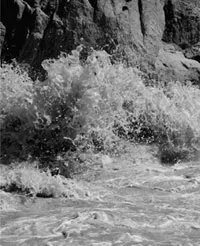![]()
Part 1
Global Overview
![]()
Chapter 1
Scope and Scale
Exploding wave, Colorado River, USA
Contents
Key Issues
Chapter Summary
Research Review
Big Picture
Looking Back
Key Issues
Scope
- defining adventure tourism
- related terms and sectors
- history of the concept
- activities involved
- structure of the sector
- review of academic and grey literature
Scale
- how to estimate the economic scale of the adventure tourism sector
- components and boundaries
- valuation and estimation measures and methods
- review of actual estimates for particular sectors and places
- range of estimates for the global industry
- adventure tourism as a trillion-dollar sector
- add-ons such as amenity migration and associated property markets
Chapter Summary
Scope
Adventure tourism is a broad term which encompasses all types of commercial outdoor tourism and recreation with a significant element of excitement. It is closely related to nature-based tourism, with some overlap. Whilst nature-based tourism products focus on seeing, however, adventure tourism products focus on doing.
A wide range of outdoor recreation activities have been packaged as commercial adventure tour products, from short, low-key hiking trips to expensive and equipment-intensive tours involving helicopters and expedition cruise vessels.
Adventure tourism is sometimes also taken to include independent travel which provides or is perceived by the travellers themselves as providing, an adventurous experience. At the other end of the spectrum, it may also be taken to include large-scale, fixed-site outdoor sporting facilities such as ski resorts and yacht marinas, and associated retail and residential components. Here, however, the focus is on packaged commercial retail adventure tourism products purchasable by individual consumers.
Scale
There are basically two different approaches to estimate the economic scale of the adventure tourism sector: top-down or bottom-up. The former relies on calculating what proportion of the tourism industry as a whole consists of adventure tourism. The latter relies on estimating the economic scale of every individual adventure tourism operation or at least subsector, and aggregating these into a cumulative figure for the adventure tourism industry as a whole. With perfect data and unambiguous definitions, these two approaches should yield the same result. In practice, since both data and definitions are rather incomplete and unreliable, the two approaches can yield quite different results. The degree to which they correspond, however, can provide an indication of how reliable they may be.
It is only in recent decades that countries have begun to estimate the scale of their tourism industries at all, since historically this was not included as one of the calculation components for GNP. Tourism satellite accounts are now widespread in a number of nations, but still not particularly precise. It is notable, for example, that the peak international tourism industry association, the World Travel and Tourism Council, estimates global tourism turnover at around $7 trillion per year, whereas the peak intergovernmental body, the UN World Tourism Organisation, gives a considerably smaller figure. Even if we can estimate accurately what proportion of the overall tourism industry consists of adventure tourism, therefore, we still have to decide which of these whole-of-sector estimates to use as a starting point.
Even taking those uncertainties into account, it seems clear that adventure tourism is now a large industry sector, with an annual global turnover estimated at around one trillion US dollars. More precise measures depend firstly, on defining exactly what is or is not included; and secondly, on obtaining accurate statistics for different subsectors and components.
Research Review
Scope
The term adventure tourism is relatively new in academic research. Reviews of the adventure tourism literature less than 5 years ago (Buckley 2006a, 2006b) indicated that of around 350 publications relevant to the field, most had originated either in parks and recreation research, in sport and travel medicine, or in tourism economics. Of these, around 27% were related to environmental impacts, 22% to participant perceptions, 16% to commercial aspects such as product structures, and 11–12% each to economic scale, risks and accidents, and conflicts between different activities. There are still very few books either on adventure tourism specifically (Swarbrooke et al., 2003; Buckley, 2006a) or on related areas such as adventure sports (Hudson, 2002; McNamee, 2007), adventure programming (Priest and Gass, 2005), tourism in adventurous terrain (Godde et al., 2000; Prideaux and Cooper, 2009) or tourism in adventurous regions (Baldacchino, 2006; Snyder and Stonehouse, 2007; Spenceley, 2008).
The scope of adventure tourism has commonly been expressed through lists of specific outdoor activities involved. Buckley (2006a) listed 35–40 such activities, some of them in aggregated categories. In alphabetical order, these were: abseiling, aerobatic aircraft flights, ballooning, black water rafting, bungy jumping, caving, cross-country skiing, diving, downhill skiing and snowboarding, expedition cruises, gliding, hang gliding, heliskiing and heliboarding, hiking, horse riding, ice climbing, jet boating, kiteboarding, mountain biking, mountaineering, off-road 4WD driving, parapenting and paragliding, quad biking and ATV driving, rock climbing, sailboarding, sailing, sea kayaking, skydiving and parachuting, snowshoeing, surfing, whale watching, whitewater canoeing and kayaking, whitewater rafting, wildlife watching and zorbing. This list is by no means exhaustive, and many of these categories could be subdivided.
In that volume, the term adventure tourism was taken to mean ‘guided commercial tours where the principal attraction is an outdoor activity that relies on features of the natural terrain, generally requires specialised sporting or similar equipment, and is exciting for the tour clients’. This definition ‘does not require that the clients themselves operate the equipment: they may simply be passengers…’. Buckley (2006a) went on to examine critical components of this definition, such as distinctions between tourism and recreation and between fixed and mobile activities. The roles of skills, risks and remoteness in defining adventure have also been referred to by a number of authors, reviewed by Buckley (2006a, 2007a). Typologies of adventure tourism have also been put forward by authors such as Trauer (2006), Mehmetoglu (2007) and Weber (2007).
A number of authors have focussed more on adventure tourists and their motivations, expectation and experiences, than on adventure tourism products and activities (Swarbrooke et al., 2003). Tran and Ralston (2006) found that many adventure tourists are people who are motivated by achievements, whilst Patterson et al. (2007) examined what attracts the baby-boomer generation to adventure tourism. Sung (2007) used mail surveys from 1000 of the 60,000 members of the Adventure Club of North America to classify them numerically into various subgroups. Kane and Zink (2007) described interviews with seven Americans on a commercial kayak tour in New Zealand.
A significant proportion of the research analyses in adventure tourism focus on specific adventure activities rather than the sector as a whole. Examples include: Smith (2006) on commercial expedition yacht cruising; Mograbi and Rogerson (2007) on dive tourism, Buckley (2009b) on whitewater raft and kayak tours; and Costa and Chalip (2007) on skydiving tourism in northern Portugal.
Scale
Economic scale, value and impact have been examined for a number of adventure tourism activities and regions. Techniques and examples of such analyses were reviewed by Buckley (2009a, pp. 82–116, 269–292), who emphasised two particular aspects. The first is selecting which precise components to include or exclude, and how to define them. The second is selecting techniques to estimate the economic size of each component, whether market or non-market. Texts on the economics of outdoor tourism include those of Hanley et al. (2003) and Tisdell (2001, 2005). Reviews of techniques to estimate economic values include Azqueta and Sotelsek (2007) and Bebbington et al. (2007). Reviews of techniques to estimate economic impact include Frechtling (2006), Alpizar (2006), Loomis (2006) and Stynes and White (2006).
Examples of regional scale cross-activity estimates include Mallett (1998) for the USA, Buckley (1998a) for Australia and Page et al. (2005) for Scotland. There are estimates of economic scale or impact for: mountain biking (Chavez, 1996a,1996b; Fix and Loomis, 1997); off-road driving (Bowker, 2001); climbing (Hanley, 2002; Hanley et al., 2001, 2003; Grijalva et al., 2002); whitewater rafting and kayaking (Bowker et al., 1996; English and Bowker, 1996a,1996b; Northeast Natural Resource Centre, 1997; Buultjens and Davis, 2001; Siderelis and Moore, 2006); diving (Cope, 2003; Green and Donnelly, 2003) and whale watching (Duffus and Dearden, 1993; Davis and Tisdell, 1996, 1998; Hoyt, 2000; Parsons et al., 2003; Woods-Ballard et al., 2003; Rodger and Moore, 2004).
The economic scale, value and impacts of various types of wildlife adventure tourism in Africa have been examined by, e.g. Borge et al. (1991) and Mmopelwa et al. (2007) in Botswana; Barnes et al. (1992, 1999) and Barnes and Jager (1996) in Namibia; Archabald and Naughton-Treves (2001) in Uganda; and Blom (2000) in the Central African Republic. In North America, the economics of bear-watching tourism were examined by Clayton and Mendelsohn (1993) in Alaska, and by Lemelin and Smale (2006) for polar bears in Hudson Bay. In Indonesia, Walpole and Goodwin (2000) examined the economics of tourism based on watching Komodo dragons, with particular attention to pricing policies. There are many more economic studies of tourism based on wildlife and nature (Buckley, 2009a), but most of these would not necessarily qualify as adventure tourism.
Big Picture
Scope
Adventure tourism can be defined in various ways, and there is as yet no officially accepted or generally agreed universal definition. From the perspective of the individual tourist, anything which they personally consider adventurous can be counted as adventure tourism. Different individuals, however, or even the same individual at different ages, may have widely different perceptions of how adventurous a particular activity may be, depending on prior experience, skills and interests. From a supply-side perspective, a wide range of different commercial tourism activities may be marketed as adventure tourism. There are also many activities where particular products are marketed as adventure and where other essentially identical products have been marketed and analysed under different names and labels. Certain types of wildlife tourism, for example, or marine tourism, or indeed ecotourism, may equally be treated as adventure tourism, whereas others probably would not.
Like any other component of the commercial tourism industry, adventure tourism includes accommodation, transport and activities. Most commonly, perhaps, it is the activities that spring to mind when we think of adventure tourism, but there are also examples of transport and even accommodation, which are considered adventurous in themselves. Indeed, in some cases, transport or accommodation itself becomes the activity, as in the case of Overlander tours through Africa or Asia, or the Arctic Ice Hotel in northern Sweden.
The Oxford Dictionary defines adventure as ‘unexpected or exciting experience; daring enterprise, hazardous activity’. Its Australian equivalent, The Macquarie Dictionary, gives several meanings, including ‘an exciting experience’ and ‘an undertaking of uncertain outcome; a hazardous enterprise’. The US equivalent, Websters, also gives a series of definitions, including ‘a remarkable experience’, ‘the encountering of risks; hazardous enterprise’, and ‘a bold undertaking, in which hazards are to be met and the issue hangs upon unforseen events; a daring feat’. All these definitions thus include elements of excitement, of uncertainty, and of risk and danger.
To create marketable products that can be sold repeatedly to a retail clientele so as to run a profitable business, however, each of these elements must be managed quite stringently. Clients may indeed want excitement, but they generally do not want to be terrified, and the balance between the two must be managed carefully for the particular clients and activities. Clients may want to feel that to some degree they are venturing into the uncertain and unknown, but they still want the trip to en...

